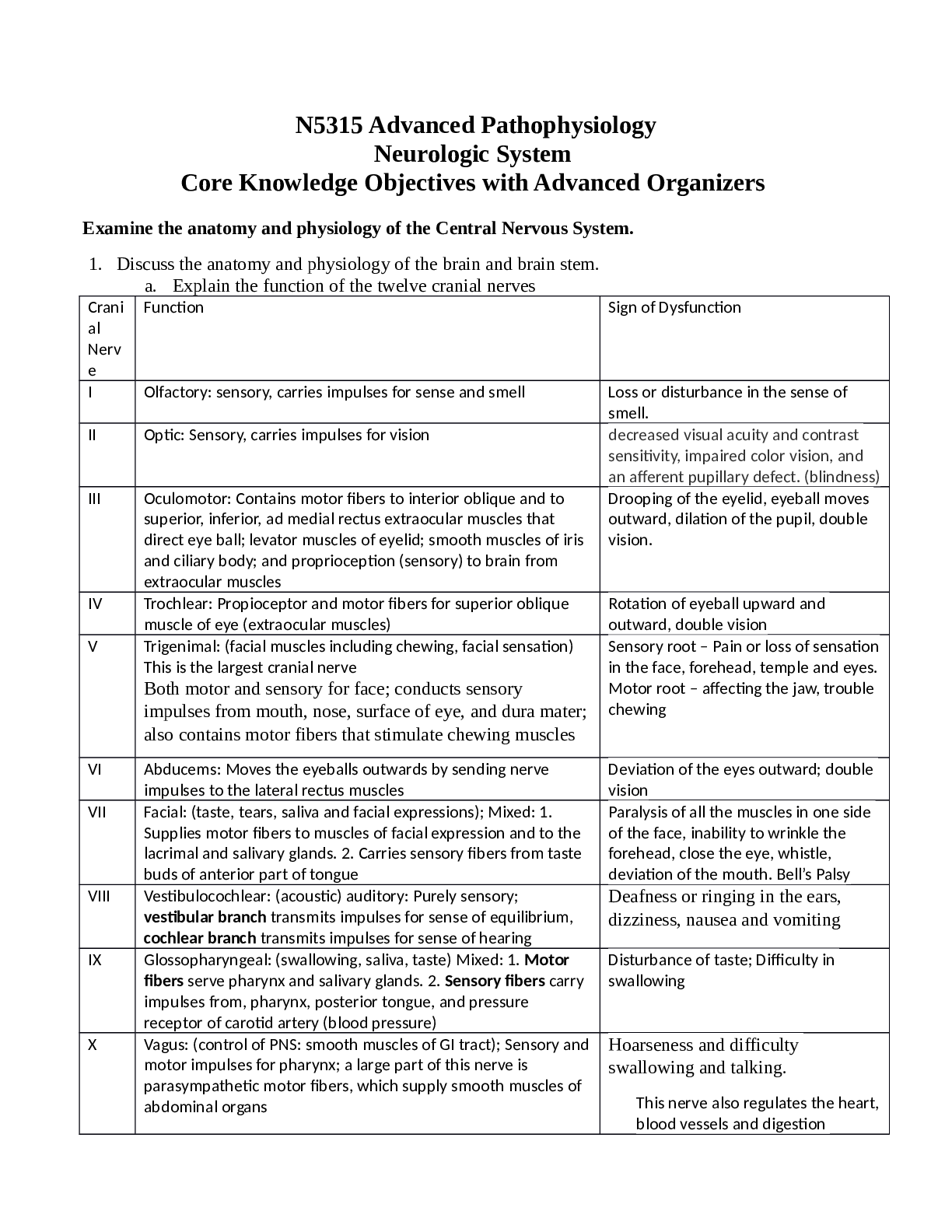*NURSING > QUESTIONS & ANSWERS > Introduction to advanced pathophysiology Advanced Pathophysiology 6501_Walden University. Week 1 Ch (All)
Introduction to advanced pathophysiology Advanced Pathophysiology 6501_Walden University. Week 1 Chapter 1 cellular biology, Chapter 2 Genes and genetic disorders, and Chapter 4 Altered cellular and tissue biology. Questions, Answers and Explanations.
Document Content and Description Below
l Introduction to advanced pathophysiology Advanced Pathophysiology (Walden University) 6501 week 1 Chapter 1 cellular biology 1. 1. A student is observing a cell under the microscope. It i... s observed to have supercoiled DNA with histones. Which of the following would also be observed by the student? a. A single circular chromosome b. A nucleus c. Free-floating nuclear material d. No organelles 2. 2. A nurse is instructing the staff about cellular functions. Which cellular function is the nurse describing when an isolated cell absorbs oxygen and uses it to transform nutrients to energy? a. Metabolic absorption b. Communication c. Secretion d. Respiration 3. 3. A eukaryotic cell is undergoing DNA replication. In which region of the cell would most of the genetic information be contained? a. Mitochondria b. Ribosome c. Nucleolus d. Nucleus 4. 4. The fluid mosaic model for biologic membranes describes membrane behavior. According to this model, which of the following float singly or as aggregates in the fluid lipid bilayer? a. Peripheral membrane proteins b. Integral membrane proteins c. Glycoproteins d. Cell adhesion molecules 5. 5. Which of the following can bind to plasma membrane receptors? a. Oxygen b. Ribosomes c. Amphipathic lipids d. Ligands 6. 6. A nurse is reviewing a report from a patient with metastatic cancer. What finding would support the diagnosis of metastatic cancer? Alterations in extracellular matrix that include: a. Decreased fibronectin b. Increased collagen c. Decreased elastin d. Increased glycoproteins 7. 7. Which form of cell communication is used to relate to other cells in direct physical contact? a. Cell junction b. Gap junction c. Desmosomes d. Tight junctions 8. 8. Pancreatic beta cells secrete insulin, which inhibits secretion of glucagon from neighboring alpha cells. This action is an example of which of the following signaling types? a. Paracrine b. Autocrine c. Neurohormonal d. Hormonal 9. 9. In cellular metabolism, each enzyme has a high affinity for a: a. Solute b. Substrate c. Receptor d. Ribosome 10. 10. An athlete runs a marathon, after which his muscles feel fatigued and unable to contract. The athlete asks the nurse why this happened. How should the nurse respond? A deficiency in can cause impaired muscle contraction. a. GTP b. AMP c. ATP d. GMP 11. 11. Which phase of catabolism produces the most ATP? a. Digestion b. Glycolysis c. Oxidation d. Citric acid cycle 12 12. A nurse is teaching the staff about the . three phases of cellular catabolism. Which of the following should the nurse include? a. Digestion, glycolysis and oxidation, and the citric acid cycle b. Diffusion, osmosis, and mediated transport c. S phase, G phase, and M phase d. Metabolic absorption, respiration, and excretion 13 13. A runner has depleted all the oxygen . available for muscle energy. Which of the following will facilitate his continued muscle performance? a. Electron-transport chain b. Aerobic glycolysis c. Anaerobic glycolysis d. Oxidative phosphorylation 14 14. The faculty member asked the student to . identify the appropriate term for the movement of small, electrically uncharged molecules through a semipermeable barrier. Which answer indicates the nursing student understood the teaching? a. Osmosis b. Diffusion c. Hydrostatic pressure d. Active transport 15 15. A nurse is teaching a patient about fluid . and electrolytes. Which of the following indicates the teaching was successful regarding electrolytes? Electrolytes are: a. Small lipid-soluble molecules b. Large protein molecules c. Micronutrients used to produce ATP d. Electrically charged molecules 16 16. A nurse is reading a chart and sees the . term oncotic pressure. The nurse recalls that oncotic pressure (colloid osmotic pressure) is determined by: a. Concentration of sodium b. Plasma proteins c. Hydrostatic pressure d. Availability of membrane transporter proteins 17 17. A patient has a body fluid of 300 . mOsm/kg. This lab result is measuring: a. Osmolality b. Osmolarity c. Osmotic pressure d. Oncotic pressure 18 18. In teaching a patient with cirrhosis, . which information should the nurse include regarding cholesterol? a. Cholesterol decreases the membrane fluidity of the erythrocyte, which reduces its ability to carry oxygen. b. Cholesterol decreases the membrane fluidity of erythrocytes, which reduces its ability to carry hemoglobin. c. Cholesterol increases the membrane fluidity of erythrocytes, which allows binding of excess glucose. d. Cholesterol increases the membrane fluidity of erythrocytes, which prolongs its life span beyond 120 days. 19 19. A nurse is discussing the movement . of fluid across the arterial end of capillary membranes into the interstitial fluid surrounding the capillary. Which process of fluid movement is the nurse describing? a. Hydrostatic pressure b. Osmosis c. Diffusion d. Active transport 20 20. A patient who has diarrhea receives a . hypertonic saline solution intravenously to replace the sodium and chloride lost in the stool. What effect will this fluid replacement have on cells? a. Cells will become hydrated. b. Cells will swell or burst. c. Cells will shrink. d. Cells will divide. 21 21. A nurse is teaching a patient with . diabetes how glucose is transported from the blood to the cell. What type of transport system should the nurse discuss with the patient? a. Active-mediated transport (active transport) b. Active diffusion c. Passive osmosis d. Passive-mediated transport (facilitated diffusion) 22 22. How are potassium and sodium . transported across plasma membranes? a. By passive electrolyte channels b. By coupled channels c. By adenosine triphosphate enzyme (ATPase) d. By diffusion 23 23. Why is potassium able to diffuse . easily in and out of cells? a. Because potassium has a greater concentration in the intracellular fluid (ICF) b. Because sodium has a greater concentration in the extracellular fluid (ECF) c. Because the resting plasma membrane is more permeable to potassium d. Because there is an excess of anions inside the cell 24 24. The ion transporter that moves Na+ . and Ca2+ simultaneously in the same direction is an example of which of the following types of transport? a. Biport b. Uniport c. Antiport d. Symport 25 25. During which process can lysosomal . enzymes be released to degrade engulfed particles? a. Endocytosis b. Pinocytosis c. Phagocytosis d. Exocytosis 26 26. A nurse is teaching the staff about . cholesterol. Which information should be taught? The cellular up- take of cholesterol depends on: a. Active-mediated transport b. The antiport system 27. is not a part of the antiport system. The cellular uptake of cholesterol depends on receptor-mediated endocytosis; it requires 28 28. What causes the rapid change in the resting . membrane potential that initiates an action potential? a. Potassium gates open, and potassium rushes into the cell, changing the membrane potential from negative to positive. b. Sodium gates open, and sodium rushes into the cell, changing the membrane potential from nega- tive to positive. c. Sodium gates close, allowing potassium into the cell to change the membrane potential from positive to negative. d. Potassium gates close, allowing sodium into the cell to change the membrane potential from positive to negative. 29 29. A cell is isolated, and electrophysiology . studies reveal that the resting membrane potential is -70 millivolts. The predominant intracellular ion is Na+, and the predominant extracellular ion is K+. With voltage change, which of the following would result in an action potential? a. K+ rushing into the cell b. Na+ rushing into the cell c. Na+ rushing out of the cell d. K+ rushing out of the cell 30 30. A nurse is teaching the staff about platelet- . derived growth factor. Which information should the nurse include? Platelet-derived growth factor (PDGF) stimulates the production of: a. Platelets b. Epidermal cells c. Connective tissue cells d. Fibroblast cells 31 31. The phase of the cell cycle during which . the centromeres split and the sister chromatids are pulled apart is referred to as: a. Anaphase b. Telophase c. Prophase d. Metaphase 32 32. What is the role of cytokines in cell . reproduction? a. Provide growth factor for tissue growth and development b. Block progress of cell reproduction through the cell cycle c. Restrain cell growth and development d. Provide nutrients for cell growth and development 33 33. A biopsy of the lung bronchi revealed . ciliated epithelial cells that are capable of secretion and absorption. These cells are called columnar epithelium. a. Simple b. Ciliated simple c. Stratified d. Pseudostratified ciliated 34 34. The nurse would be correct in identifying . the predominant extracellular cation as: a. Sodium b. Potassium c. Chloride d. Glucose . 35 35. The student is reviewing functions of . the cell. The student would be correct in identifying the primary function of the nerve cell as: a. Sensory interpretation b. Conductivity c. Maintenance of homeostasis d. Communication 36 36. The student is studying for a . pathophysiology exam and is trying to remember the definition of amphipathic. The student should choose which of the following to be correct? a. All cells have a membrane that is composed of lipids. b. Cells have organelles that have specialized function. c. Molecules are polar with one part loving water and one part hating water. d. Cells have receptor sites that other substances attach to and create additional functions. 37 1. A nurse recalls that the four basic . types of tissues are (select all that apply): a. Nerve b. Epithelial c. Mucosal d. Connective e. Skeletal f. Muscle 38 2. Characteristics of prokaryotes include . which of the following? (Select all that apply.) a. They contain no organelles. b. Their nuclear material is not encased by a nuclear membrane. c. They contain a distinct nucleus. d. They contain histones. e. They contain a cellular membrane. week 1 chapter 2 genes and genetic disorders 1 A nurse recalls the basic components of DNA are: b. a phosphate molecule, . a. pentose sugars and four phosphate bases. b. a phosphate molecule, deoxyribose, and four nitrogenous bases. c. adenine, guanine, and purine. d. codons, oxygen, and cytosine. 2 Which of the following mutations have the most significant effect on deoxyribose, and four nitrogenous bases. d. Frameshift mutations . protein synthesis? a. Base pair substitutions b. Silent mutations c. Intron mutations d. Frameshift mutations 3 The base components of DNA are: c. A, G, C, and T. . a. A, G, C, and U. b. P, G, C, and T. c. A, G, C, and T. d. X, XX, XY, and YY. 4 A DNA strand has a region with the sequence ATCGGAT. Which of the b. TAGCCTAG . following would be a complementary strand? a. CGATACGT b. TAGCCTAG c. TUGCCTUG d. UAGCCUAG 5 A biologist is explaining how RNA directs the synthesis of protein. d. Translation . Which process is the biologist describing? a. Termination b. Transcription c. Translocation d. Translation 6 What is the result of homologous chromosomes failing to separate during b. Nondisjunction . meiosis? a. Neurofibromatosis b. Nondisjunction c. Polyploidy d. Conjoined twins 7 A cell that does not contain a multiple of 23 chromosomes is called a . cell. a. diploid b. euploid c. polyploid d. haploid 8. A 20-year-old pregnant female gives birth to a stillborn child. Autopsy reveals that the fetus has 92 chromosomes. What term may c. polyploid c. Tetraploidy be on the autopsy report to describe this condition? a. Biploidy b. Triploidy c. Tetraploidy d. Aneuploidy 9. The condition in which an extra portion of a chromosome is present in each cell is called: a. reciprocal translocation. b. partial trisomy. c. inversion. d. Down syndrome. 10. After a geneticist talks to a patient about being a chromosomal mosaic, the patient asks the nurse what that means. How should the nurse respond? You may genetic disease(s). a. only be a carrier of the b. have a mild form of the c. have two d. be sterile as a result of the 11. What is the most common cause of Down syndrome? a. Paternal nondisjunction b. Maternal translocations c. Maternal nondisjunction d. Paternal translocations 12. A patient wants to know the risk factors for Down syndrome. What is the nurse's best response? a. Fetal exposure to mutagens in the uterus. b. Increased paternal age. c. Family history of Down syndrome. d. Pregnancy in women over age 35. 13. A 13-year-old girl has a karyotype that reveals an absent homologous X chromosome with only a single X chromosome present. What medical diagnosis will the nurse observe on the chart? a. Down syndrome b. Cri du chat syndrome b. partial trisomy. b. have a mild form of the c. Maternal nondisjunction d. Pregnancy in women over age 35. c. Turner syndrome c. Turner syndrome d. Fragile X syndrome 14. What genetic disorder is the result if an individual possesses an XXY chromosome configuration? a. Turner b. Klinefelter c. Down d. Fragile X 15. A patient demonstrates severe mental retardation caused by a deletion of part of chromosome 5. What genetic disorder will the nurse see documented in the chart? a. Prader-Willi syndrome b. Down syndrome c. Cri du chat syndrome d. Trisomy X 16. An aide asks the nurse why people who have neurofibromatosis will show varying degrees of the disease. Which genetic principle should the nurse explain to the aide? a. Penetrance b. Expressivity c. Dominance d. Recessiveness 17. Cystic fibrosis is caused by what gene abnormality? a. X-linked dominant b. X-linked recessive c. Autosomal dominant d. Autosomal recessive 18. A 15-year-old female is diagnosed with Prader-Willi syndrome. This condition is an example of: a. genomic imprinting. b. an autosomal recessive trait. c. an autosomal dominant trait. d. a sex-linked trait. 19. A patient, age 9, is admitted to a pediatric unit with Duchenne muscular dystrophy. When planning care the nurse recalls the patient inherited this condition through a trait that is: a. X-linked dominant. b. X-influenced. c. X-limited. d. X-linked recessive. b. Klinefelter c. Cri du chat syndrome b. Expressivity d. Autosomal recessive a. genomic imprinting. d. X-linked recessive. 20. A child is diagnosed with cystic fibrosis. History reveals that the child's parents are siblings. Cystic fibrosis was most likely the result of: a. X-inactivation. b. genomic imprinting. c. consanguinity. d. obligate carriers. c. consanguinity. 21 A 12-year-old male is diagnosed with Klinefelter syndrome. His d. XXY . karyotype would reveal which of the following? a. XY b. XX c. XYY d. XXY 22 To express a polygenic trait: b. several genes must act together. . a. genes must interact with the environment. b. several genes must act together. c. multiple mutations must occur in the same family. d. penetrance must occur. 23 What is the diagnosis of a 13-year-old female who has a karyotype c. Turner syndrome . that reveals an absent homologous X chromosome with only a single X chromosome present? Her features include a short stature, widely spaced nipples, and a reduced carrying angle at the elbow. a. Down syndrome b. Cri du chat syndrome c. Turner syndrome d. Klinefelter syndrome 24 The gradual increase in height among the human population over the b. a multifactorial trait. . past 100 years is an example of: a. a polygenic trait. b. a multifactorial trait. c. crossing over. d. recombination. 25 When discussing DNA replication, which enzyme is most important? d. DNA polymerase . a. RNA polymerase b. Transfer RNA c. Messenger RNA d. DNA polymerase 26 The regions of the heterogeneous nuclear RNA that must be spliced b. introns. . out to form functional RNA are called: a. promoter sites. b. introns. c. exons. d. anticodon. 27 A 50-year-old male was recently diagnosed with Huntington disease. d. delayed age of onset. . Transmission of this disease is associated with: a. penetrance of a trait. b. recurrence risk. c. expressivity. d. delayed age of onset. 28 What type of mutation does not change the amino acid sequence c. Silent . and thus has no observable consequence? a. Frameshift b. Spontaneous c. Silent d. Missense 29 A nurse is reviewing the pedigree chart. When checking for a . proband, what is the nurse looking for? a. The person who is first diagnosed with a genetic disease. b. The individual who has a disease gene but is phenotypically normal. c. The phenotype of genetic material. d. The codominance. a. The person who is first diagnosed with a genetic disease. 30 Which of the following disorders is manifested primarily in males? c. Muscular dystrophy . a. Cystic fibrosis b. Neurofibromatosis c. Muscular dystrophy d. Klinefelter syndrome 31 When the nurse is teaching the staff about X-linked recessive B, C, D . disorders, which information should the nurse include? (select all that apply) a. The trait is seen much more often in females than in males. b. The trait is never transmitted from father to son. c. The gene can be transmitted through a series of carrier females. d. The gene is passed from an affected father to all his daughters. e. The trait never skips generations. week 1 chapter 4 altered cellular and tissue biology 1. 1. A report comes back indicating that muscular atrophy has occurred. A nurse recalls that muscular atrophy involves a decrease in muscle cell: a. number. b. size. c. vacuoles. d. lipofuscin. 2. 2. During childhood, the thymus decreases in size, and this is referred to as what type of atrophy? a. Physiologic b. Pathologic c. Disuse d. Neurogenic 3. 3. When planning care for a cardiac patient, the nurse knows that in response to an increased workload, cardiac myocardial cells will experience hypertrophy which is an: a. increase in size. b. decrease in length. c. increase in excitability. d. decrease in number. 4. 4. A 55-year-old male with a 30-year history of smoking is examined for respiratory disturbance. Examination of his airway (bronchial) reveals that stratified squamous epithelial cells have replaced the normal columnar ciliated cells. This type of cellular adaptation is called: a. anaplasia. b. hyperplasia. c. metaplasia. d. dysplasia. 5. 5. When planning care for the pregnant patient, the nurse will recall that the mammary glands enlarge as a consequence of: a. compensatory hyperplasia. b. hormonal hyperplasia. c. hormonal anaplasia. d. compensatory anaplasia. 6. 6. A 24-year-old female presents with excessive menstrual bleeding. The physician identified endometrial changes that are due to hormonal imbalances. These cellular changes would be referred to as: a. dysplasia. b. pathologic dysplasia. c. hyperplasia. d. pathologic hyperplasia. 7. 7. A 55-year-old male is diagnosed with hepatocellular cancer secondary to hepatitis C. If the cancerous region of the liver is removed, the remaining cells would undergo: a. pathologic hyperplasia. b. pathologic metaplasia. c. compensatory hyperplasia. d. compensatory aplasia. 8. 8. A 40-year-old female's Pap smear indicates abnormal changes in the shape and organization of cervical cells. Which term would be used to identify this type of change? a. Metaplasia b. Atrophy c. Hypertrophy d. Dysplasia 9. 9. A 75-year-old male presents with chest pain on exertion. The chest pain is most likely due to hypoxic injury secondary to: a. malnutrition. b. free radicals. c. ischemia. d. chemical toxicity. 10. 10. A patient has a heart attack that leads to progressive cell injury that causes cell death with severe cell swelling and breakdown of organelles. What term would the nurse use to define this process? a. Adaptation b. Calcification c. Apoptosis d. Necrosis 11. 11. Sodium and water accumulation in an injured cell are a direct result of: a. decreased ATP production. b. karyorrhexis. c. ribosome detachment. d. dehydration. 12 12. The early dilation (swelling) of the . cell's endoplasmic reticulum results in: a. increased aerobic metabolism. 13 13. A 52-year-old male suffered a . myocardial infarction secondary to atherosclerosis and ischemia. Once blood flow is returned to the damaged heart, reperfusion injury occurs as a result of: a. oxidation stress. b. vacuolation. c. decreased intracellular calcium. d. lipid acceptor proteins. synthesis. Aerobic metabolism is a normal process and would not lead to swelling. Cellular swelling will not alter cellular DNA. A reduction in the Na+-K+ pump . 14 14. A family presents to their primary . care provider reporting headache, nausea, weakness, tinnitus, and vomiting. Which of the following would be the most likely explanation for these symptoms? a. Lead exposure b. Carbon monoxide poisoning c. Ethanol exposure d. Mercury poisoning . 15 15. A common pathway of irreversible . cell injury involves increased intracellular: a. sodium. b. potassium. c. magnesium. d. calcium. 16 16. A 50-year-old male sustained a closed . head injury as a result of a motor vehicle accident. CT scan revealed a collection of blood between the inner surface of the dura mater and the surface of the brain. Which type of injury will the nurse be caring for? a. Subdural hematoma b. Epidural hematoma c. Contusion d. Abrasion 17 17. A 20-year-old male presents to the . emergency department with a jagged sharp- force injury that is longer than it is deep. Which type of wound will the nurse be caring for? a. Stab wound b. Incised wound c. Puncture wound d. Chopping wound 18 18. A 30-year-old female presents with a . gunshot wound to the head. The wound has seared edges and a deep penetration of smoke and gunpowder fragments. This wound would be documented as a(n): a. exit. b. intermediate range entrance. c. contact range entrance. d. indeterminate range entrance. does. 19 19. A 15-year-old female presents to the ER . following a physical assault. She has internal damage to the neck with deep bruising. X-ray reveals fractures of the hyoid bone and tracheal and cricoid cartilage. Which of the following most likely caused her injuries? a. Chemical asphyxiation b. Choking asphyxiation c. Ligature strangulation d. Manual strangulation 20 20. A 55-year-old male has swelling of the . feet. Which of the following aided in the development of swelling? a. Increased ATP b. Chloride movement out of the cell c. Na+ movement into the cell d. Decreased oncotic pressure 21 21. A 35-year-old female is diagnosed with . multiple myeloma. Biopsy of the tumor reveals Russell bodies, and laboratory testing reveals kidney dysfunction. Which substance should the nurse monitor as it is accumulating in the patient's body? a. Glycogen b. Protein c. Pigment d. Melanin 22 22. A newborn male is diagnosed with albinism . based on skin, eye, and hair appearance. Which finding will support this diagnosis? a. Increased melanin b. Increased hemoproteins c. Inability to convert tyrosine to DOPA (3,4- dihydroxyphenylalanine) d. Inability to convert bile to bilirubin 23 23. A 23-year-old male develops a black eye . following a fight. When the aide asks the nurse why this occurred, the nurse's best response is that the bruising is due to an accumulation of: a. transferrin. b. bilirubin. c. albumin. d. hemosiderin. 24 24. Liquefactive necrosis occurs in the brain . because: a. debris is not digested by hydrolases. b. of protein denaturation. c. it is rich in hydrolytic enzymes and lipids. d. ischemia results in chemical injury. 25 25. A 2-year-old swallowed watch batteries. . Following ingestion, kidney function was impaired, and the heart began to fail. Which of the following was the most likely cause? a. Karyorrhexis b. Coagulative necrosis c. Ammonia accumulation d. Caseous necrosis 26 26. A group of prison inmates developed . tuberculosis following exposure to an infected inmate. On examination, tissues were soft and granular (like clumped cheese). Which of the following is the most likely cause? a. Coagulative necrosis b. Liquefactive necrosis c. Caseous necrosis d. Autonecrosis 27 27. A 50-year-old female became infected with . Clostridium bacteria and died a week later. Examination of her red blood cells revealed lysis of membranes. Which of the following was the most likely cause of her death? a. Fat necrosis b. Wet gangrene c. Gangrenous necrosis d. Gas gangrene 28 28. While reading a textbook, a student reads . the term apoptosis. The student recalls that apoptosis is a condition in which cells program themselves to: a. atrophy. b. die. c. regenerate. d. age. 29 29. A 50-year-old male . intravenous drug user is diagnosed with hepatitis C. Examination of the liver reveals cell death secondary to: a. fat necrosis. b. physiologic apoptosis. c. infection-induced apoptosis. d. pyknosis. 30 30. What principle should the . nurse remember when trying to distinguish aging from diseases? a. It is difficult to tell the difference because both processes are believed to result from cell injury. b. It is easy to tell normal processes from abnormal processes. c. Disease, unlike aging, has a genetic component. d. Aging is defined as exceeding life expectancy, but not maximal life span. 31 31. When a nurse observes muscle stiffening . occurring within 6-14 hours after death, the nurse should document this finding as the presence of: a. livor mortis. b. gangrene. c. algor mortis. d. rigor mortis. . 32 32. When a nurse is checking a urinalysis, the . finding that would alert the nurse to cellular injury is the presence of: a. slight glucose. b. excessive protein. c. blood. d. urea. . 33 33. An 86-year-old female patient has the . wasting syndrome of aging, making her vulnerable to falls, functional decline, disease, and death. The nurse knows this patient is experiencing: a. frailty. b. sarcopenia. c. somatic death. d. cellular aging. 34 34. Confirmation of somatic death is based . on: a. presence of algor mortis. b. presence of livor mortis. c. complete cessation of respiration and circulation. d. change in skin color to pale yellow. 35 A patient has been reading on the Internet that . light to moderate intake of alcohol is cardioprotective. When the patient asks the nurse what this means, the nurse should respond that the heart is protected by which of the following mechanisms? (select all that apply) a. Increased levels of high-density lipoprotein cholesterol b. Prevention of clot formation c. Reduction in platelet aggregation d. Decrease in blood pressure e. Increased collateral circulation f. Decreased folate absorption 36 After ingestion of lead, what organ systems . should the nurse monitor because they are the most sensitive to the effects of lead? (select all that apply) a. Heart b. Lungs c. Liver d. Kidneys e. Brain f. Hematopoietic [Show More]
Last updated: 1 year ago
Preview 1 out of 23 pages

Reviews( 0 )
Document information
Connected school, study & course
About the document
Uploaded On
Sep 15, 2020
Number of pages
23
Written in
Additional information
This document has been written for:
Uploaded
Sep 15, 2020
Downloads
0
Views
116

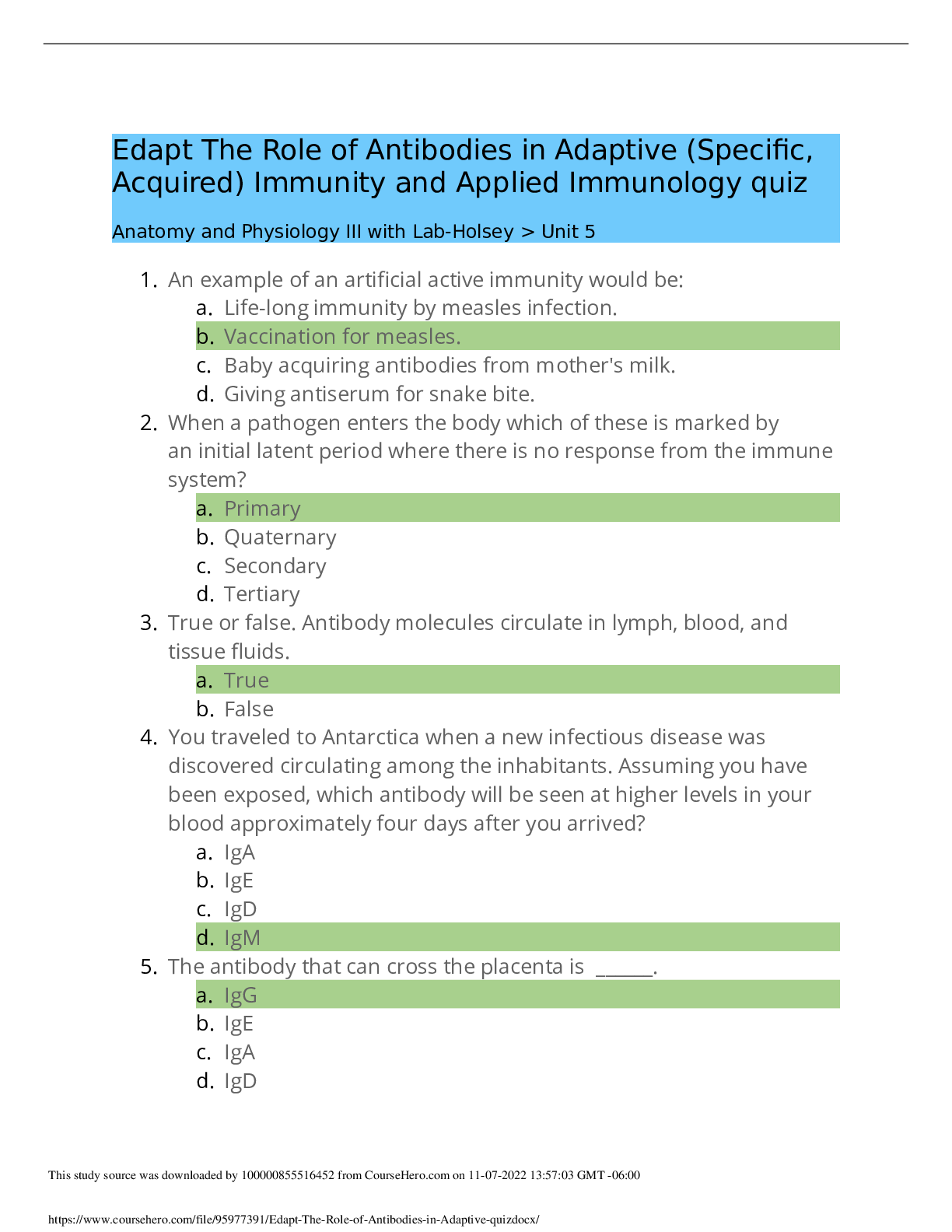
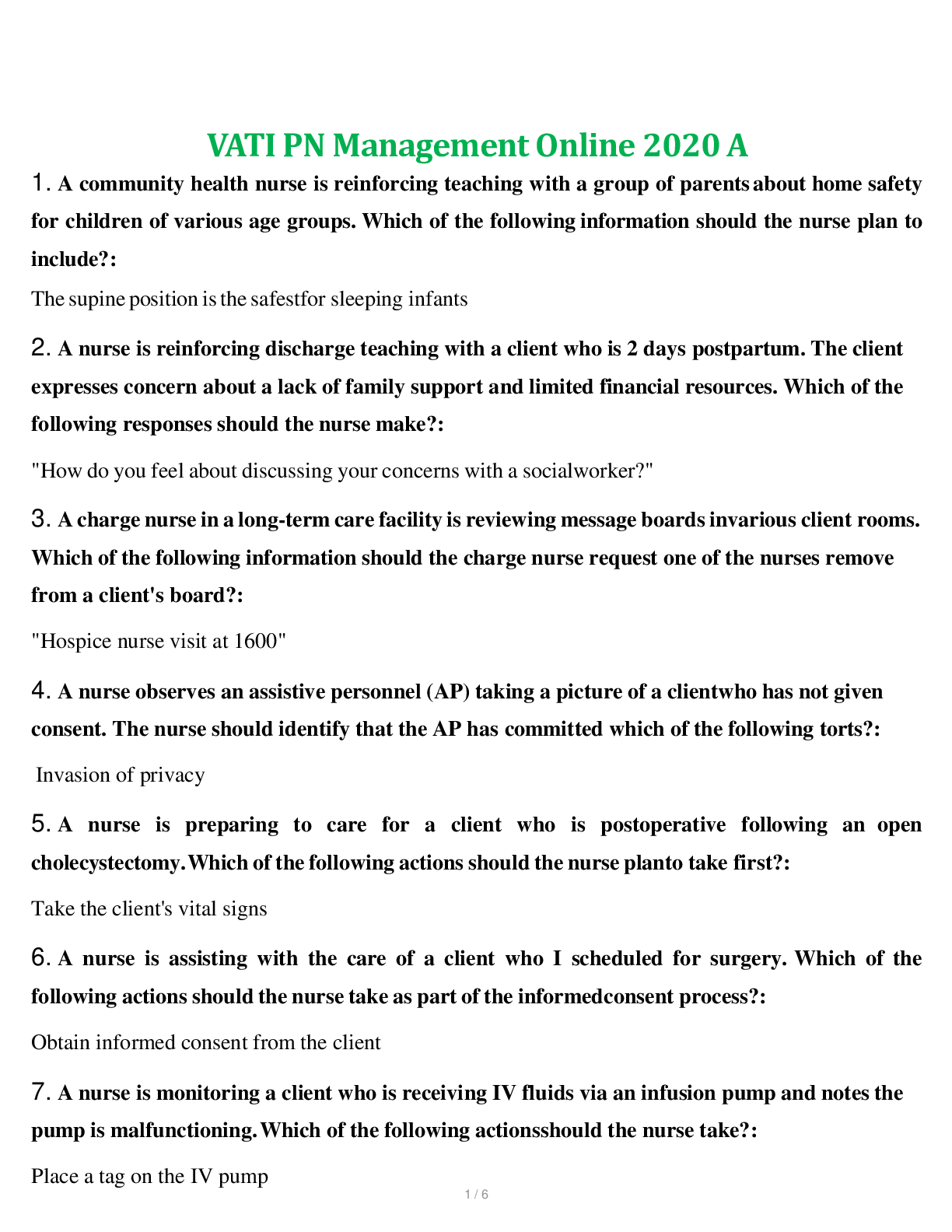


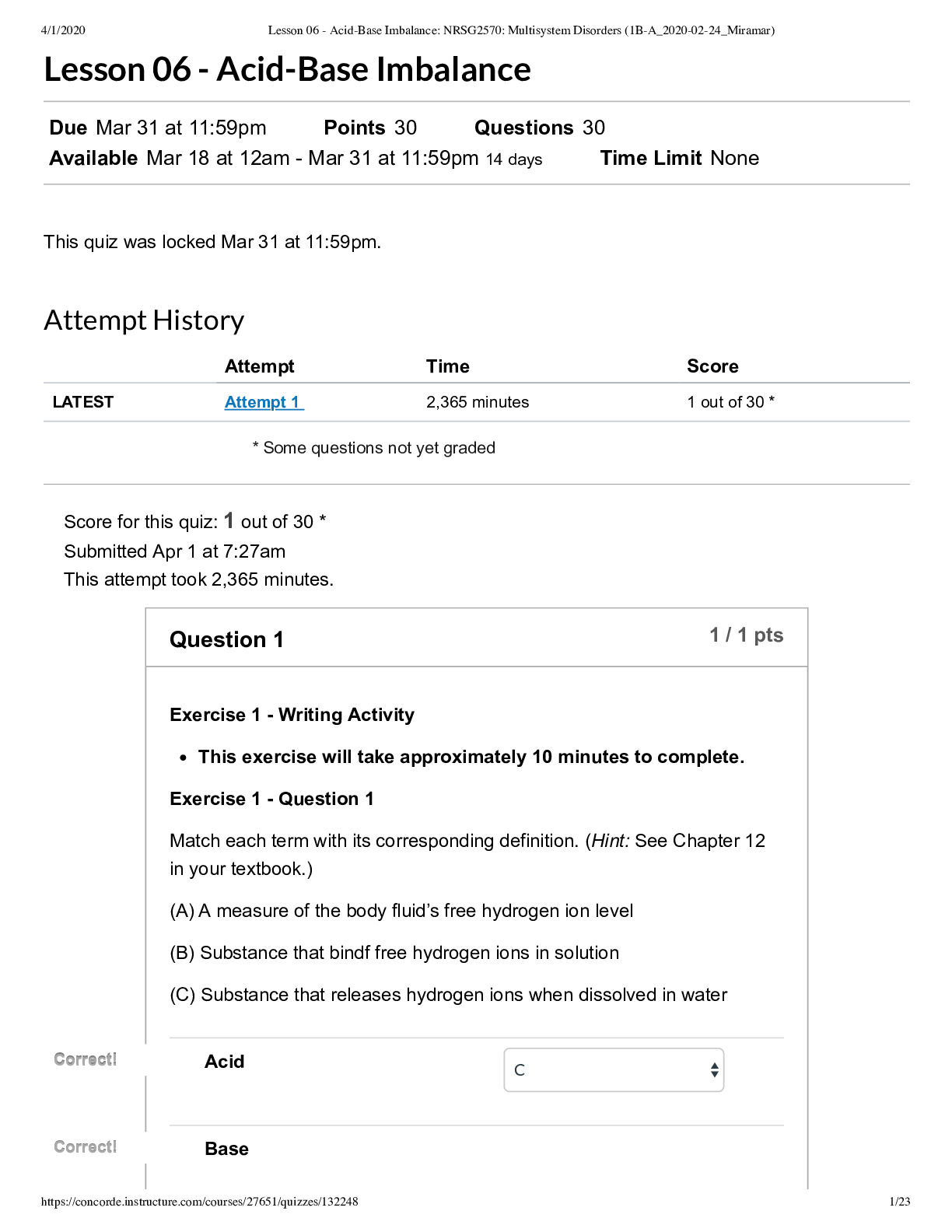


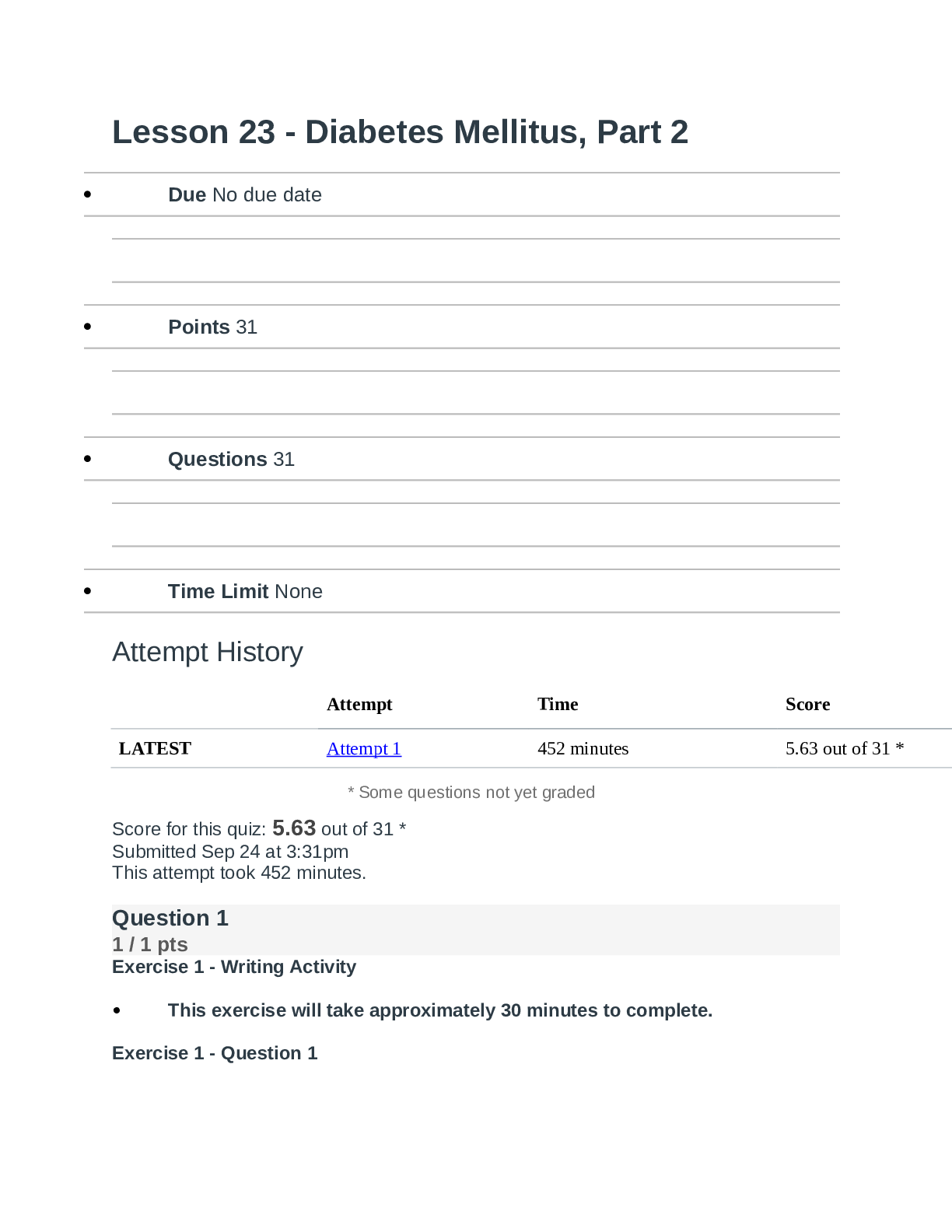

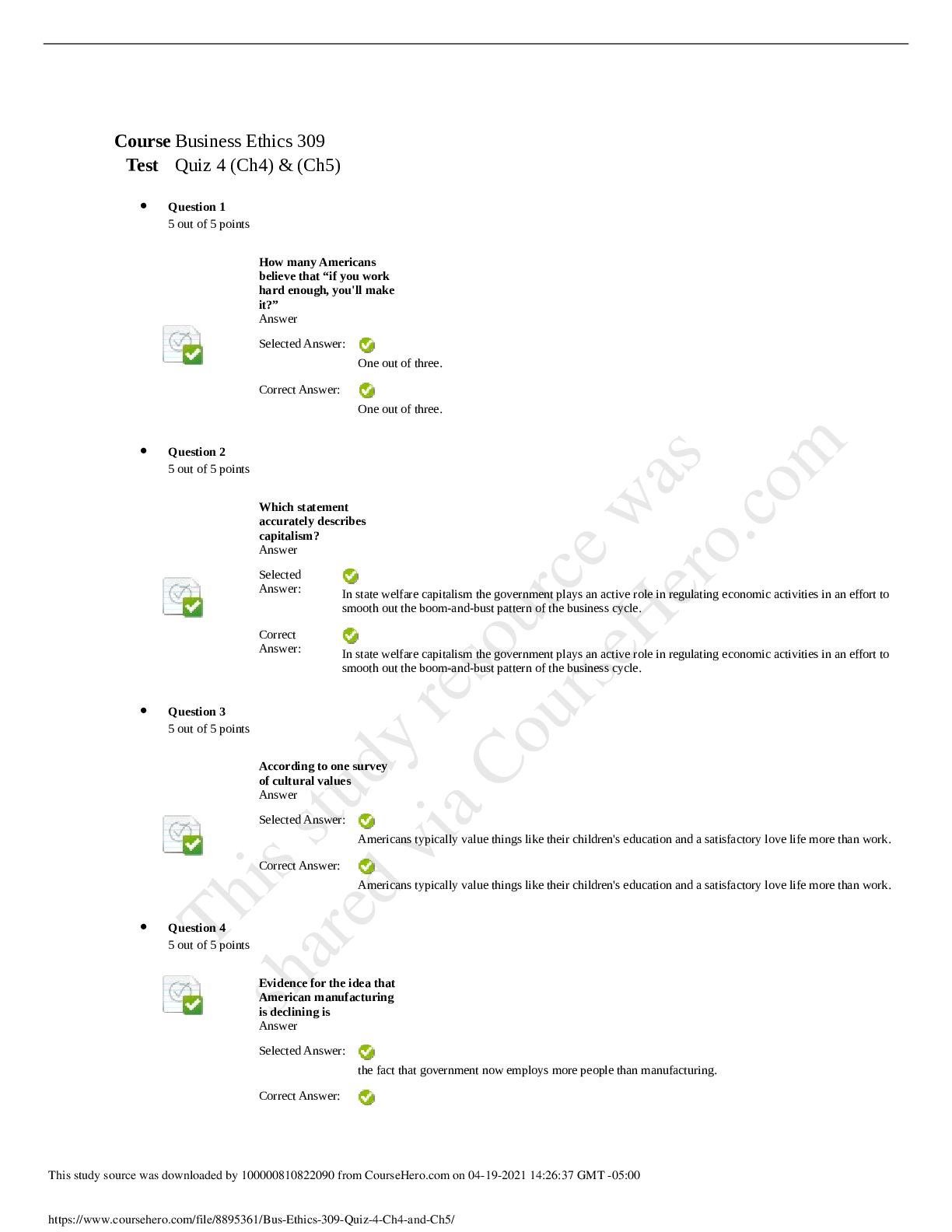








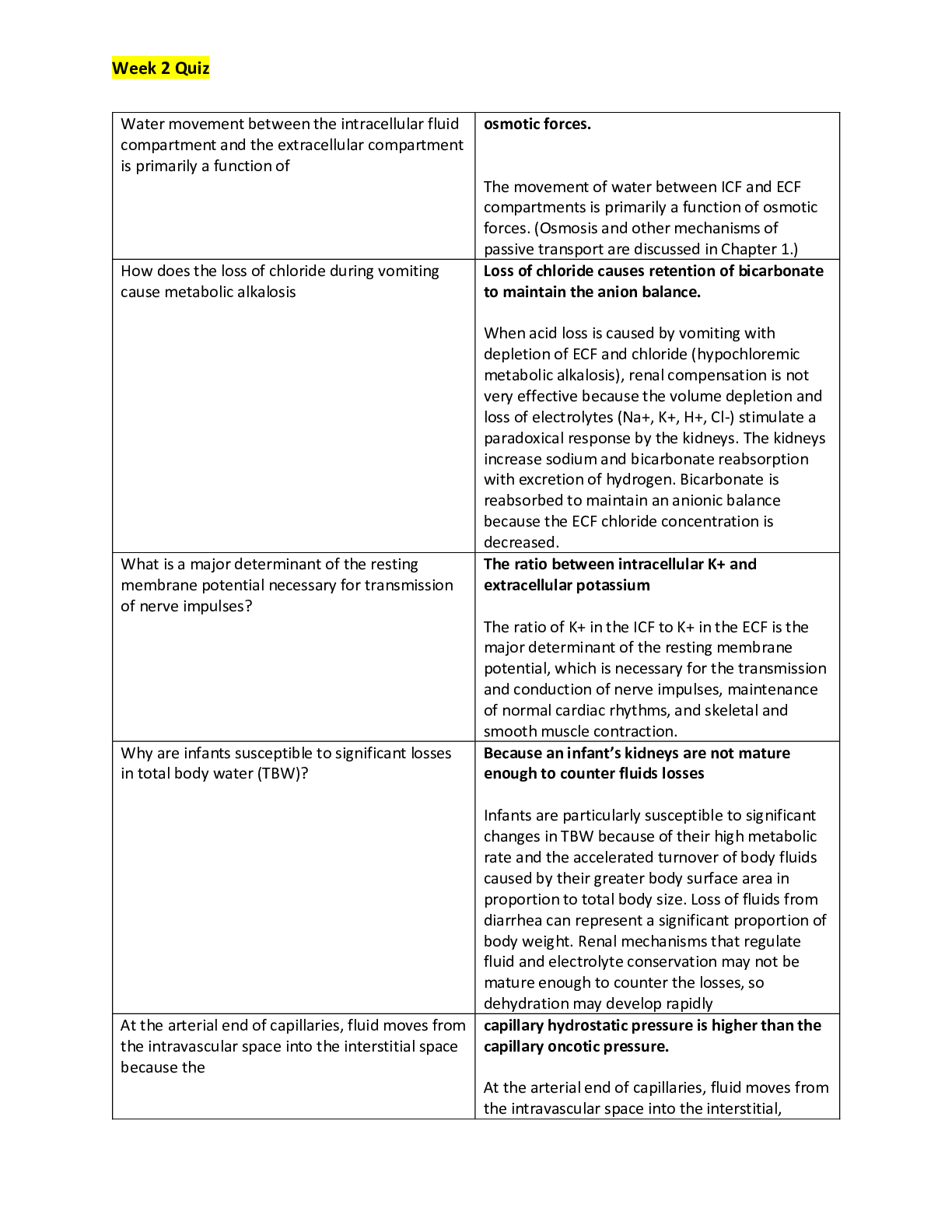
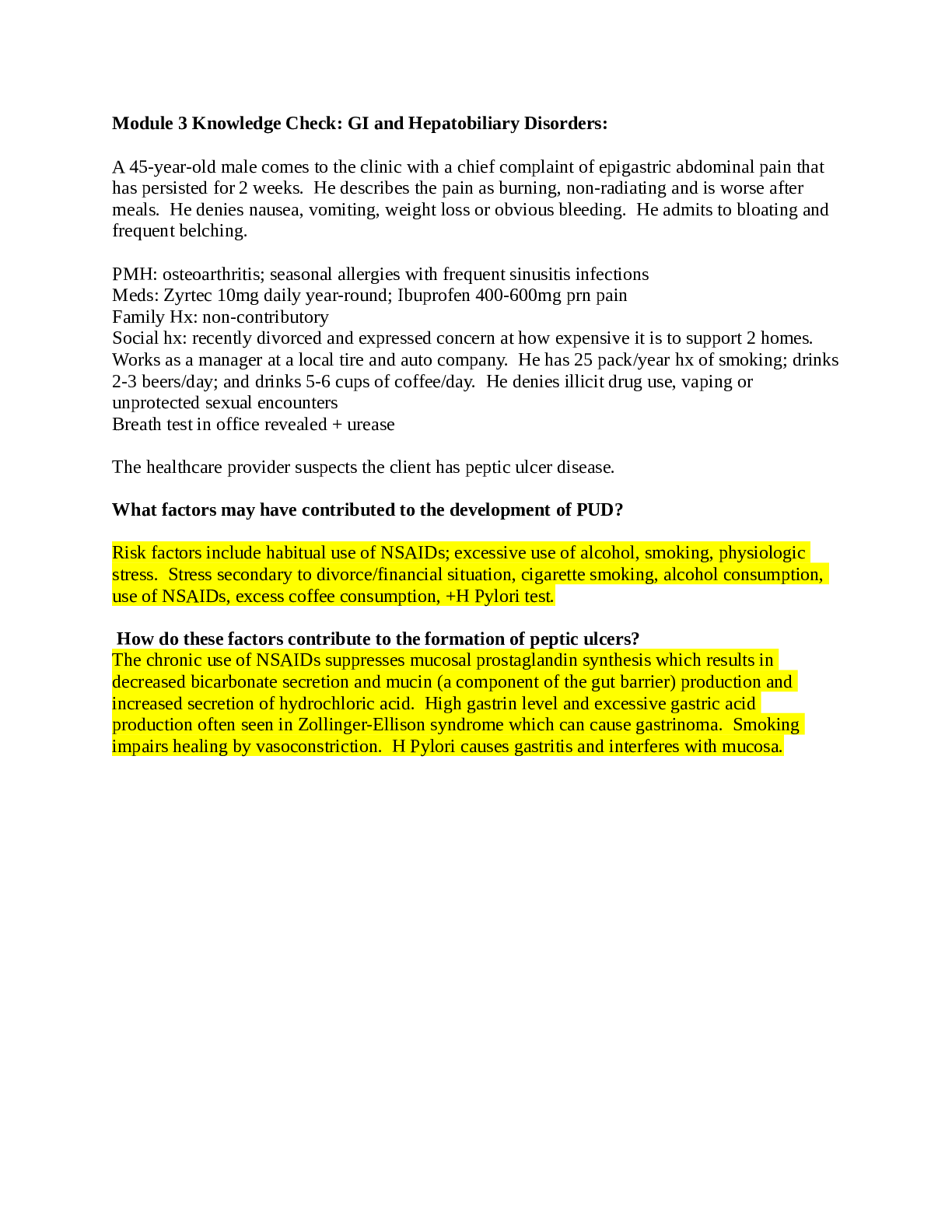
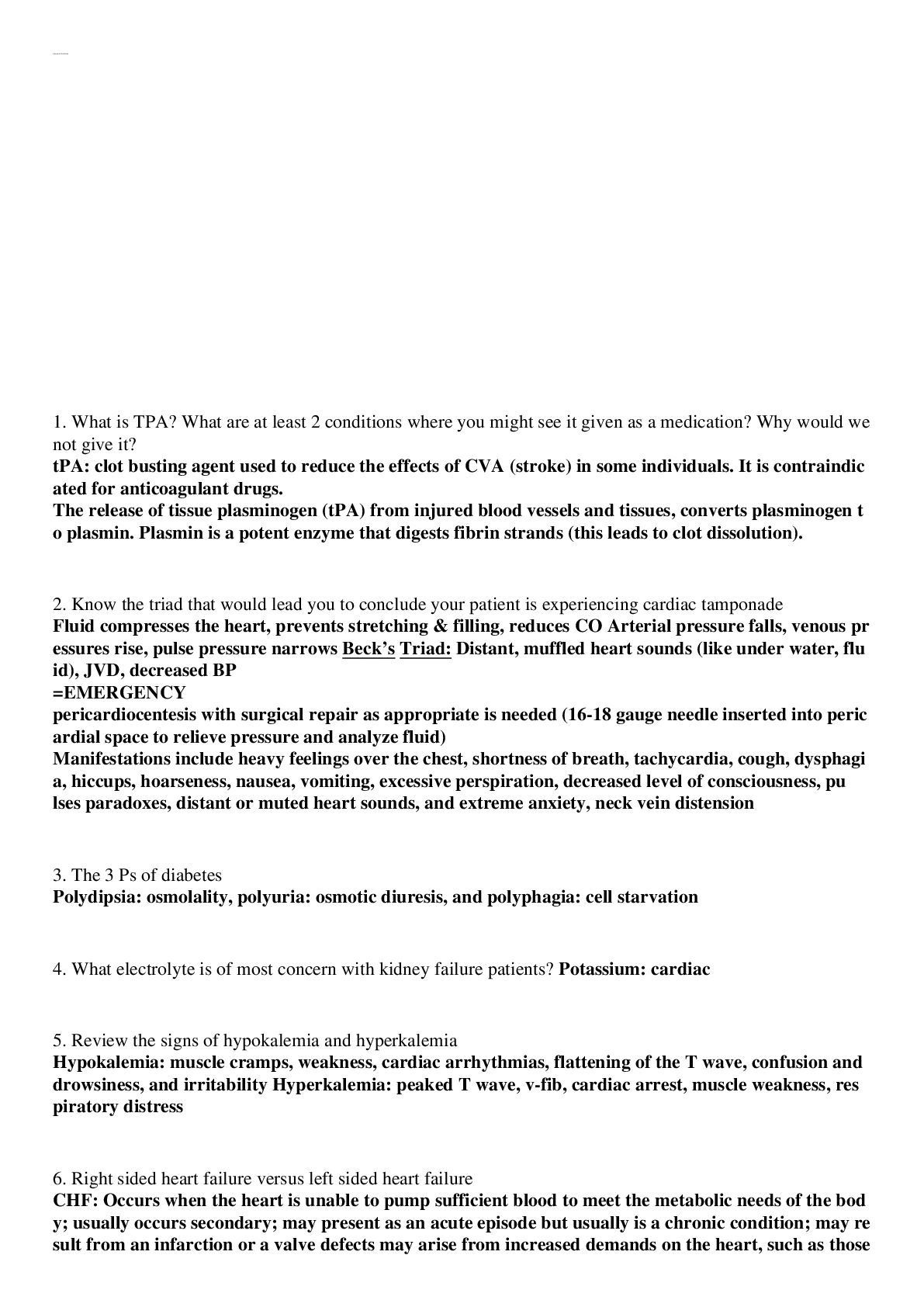

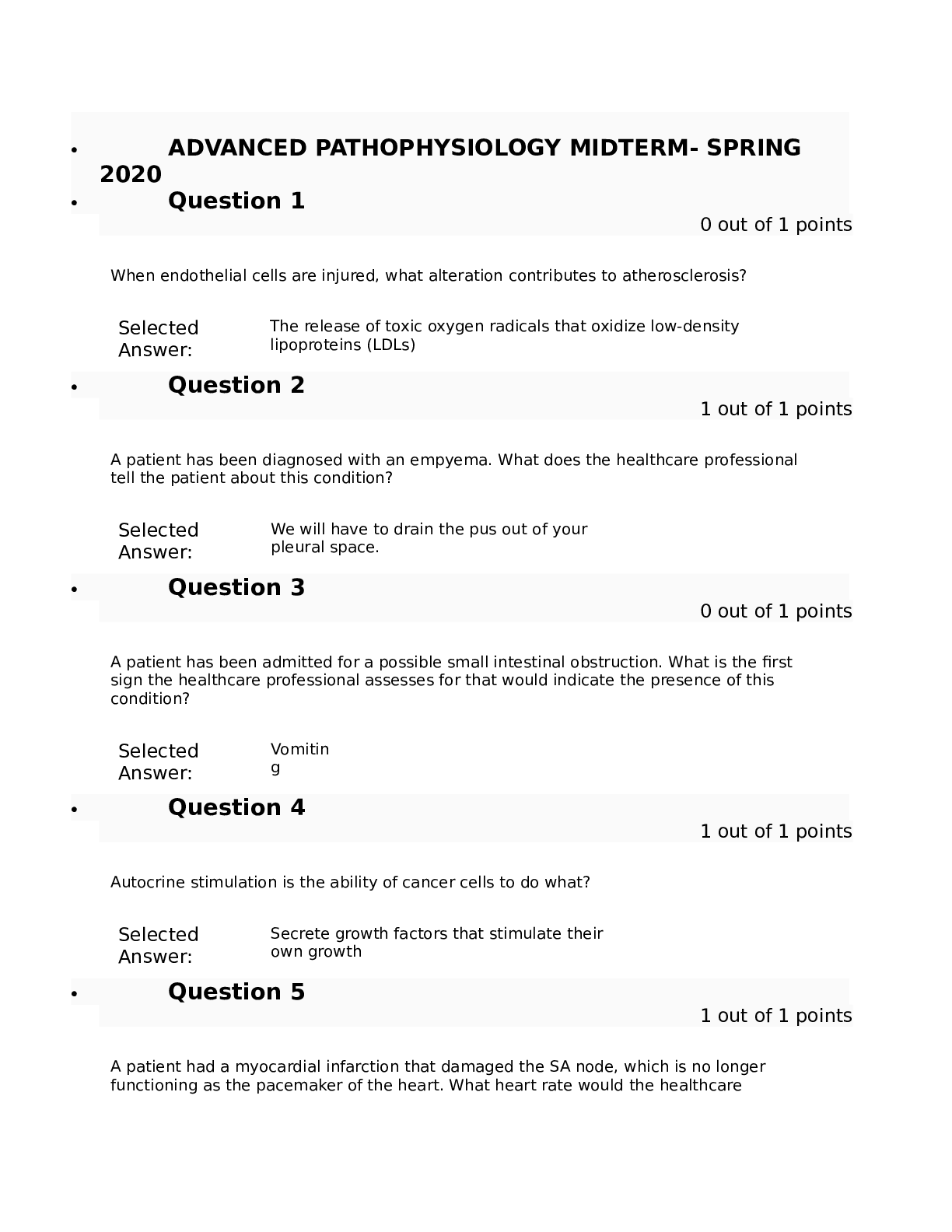
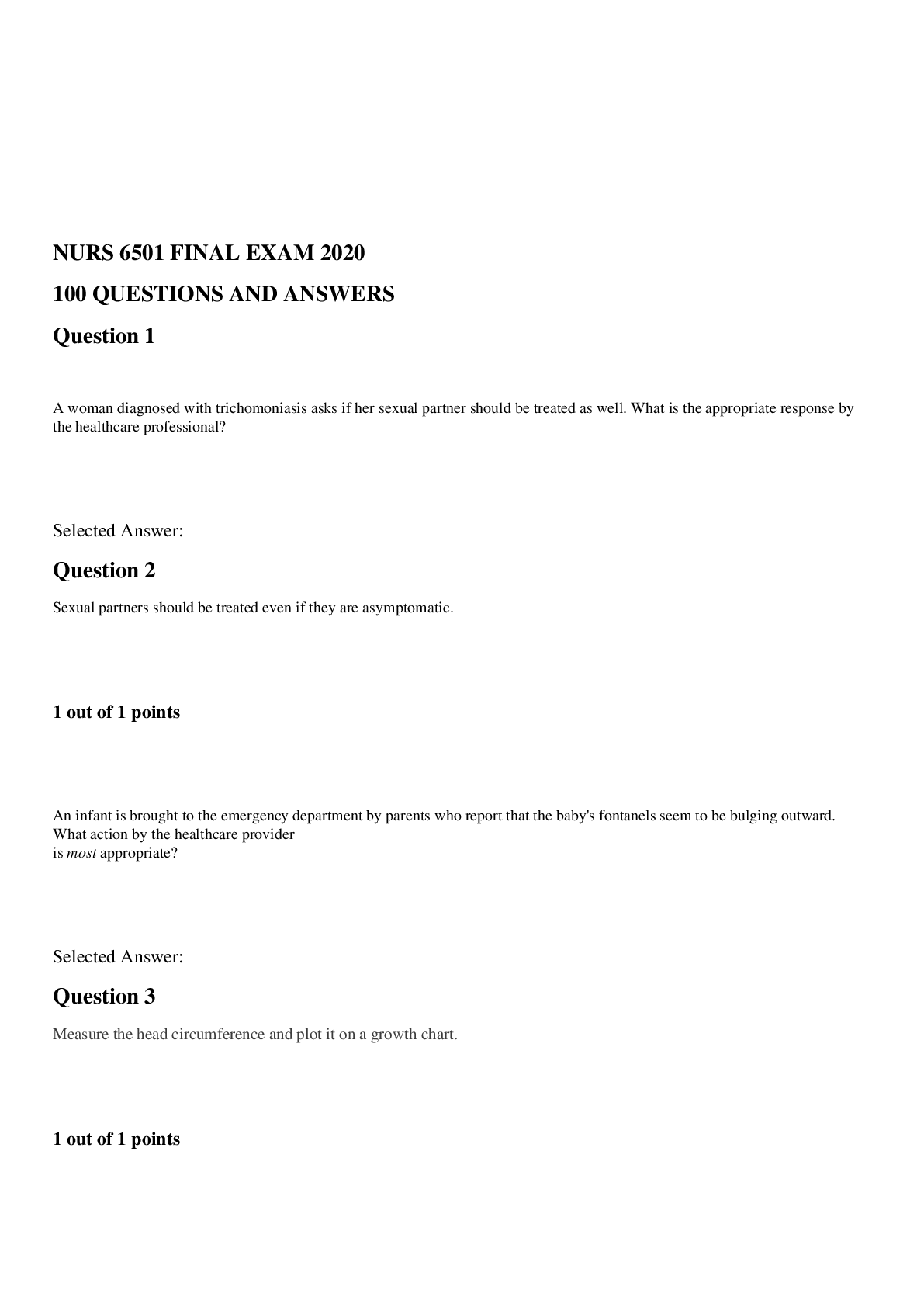
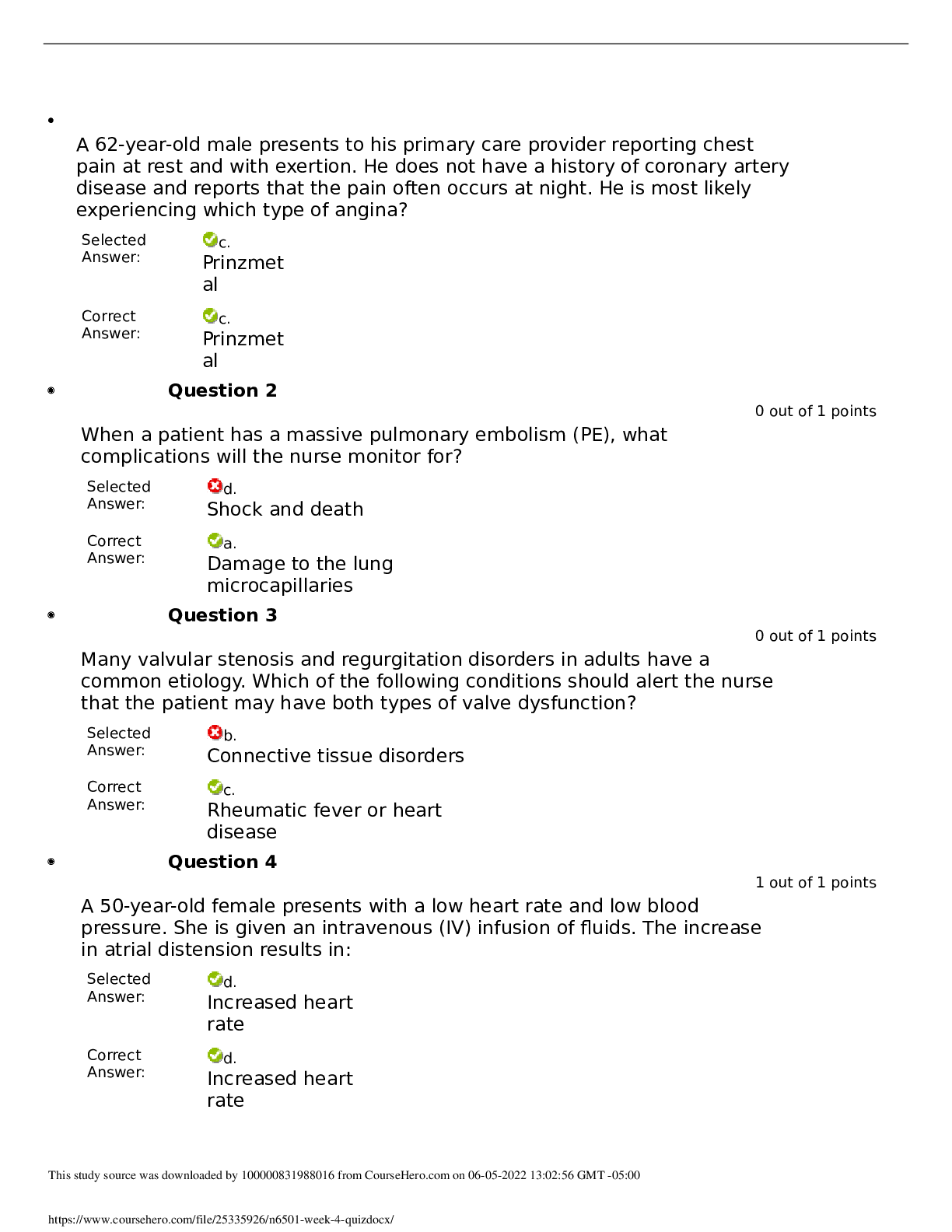
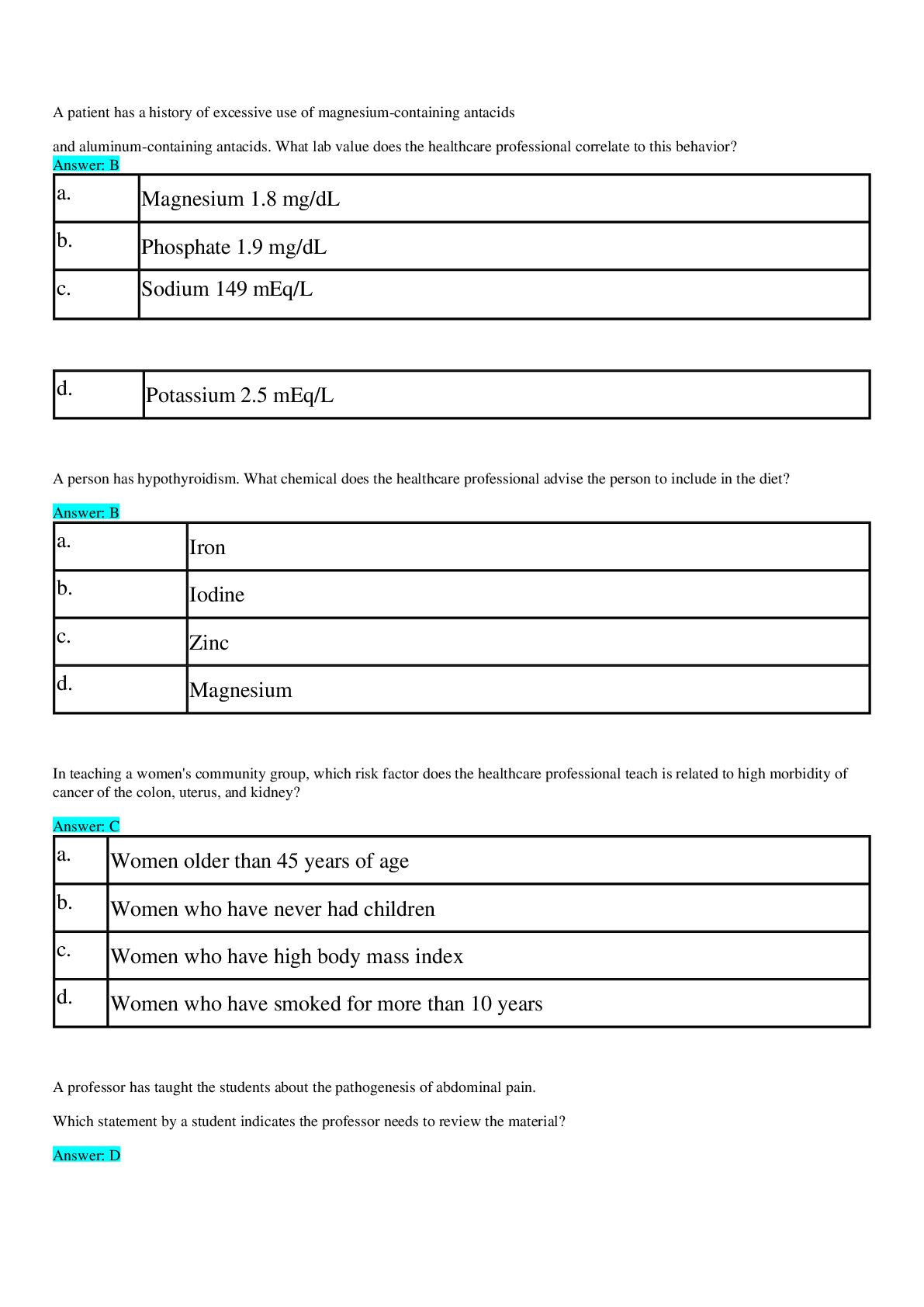



 (1).png)


